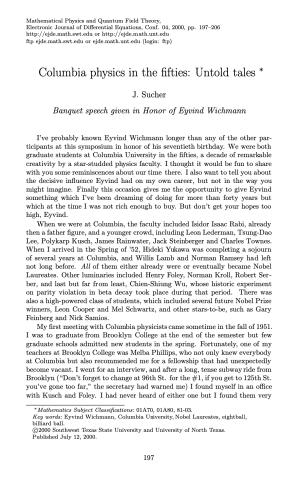Columbia physics in the fifties: Untold tales

Banquet speech given in Honor of Eyvind Wichmann
When we were at Columbia, the faculty included Isidor Isaac Rabi, already then a father figure, and a younger crowd, including Leon Lederman, Tsung-Dao Lee, Polykarp Kusch, James Rainwater, Jack Steinberger and Charles Townes. When I arrived in the Spring of ’52, Hideki Yukawa was completing a sojourn of several years at Columbia, and Willis Lamb and Norman Ramsey had left not long before. All of them either already were or eventually became Nobel Laureates. Other luminaries included Henry Foley, Norman Kroll, Robert Serber, and last but far from least, Chien-Shiung Wu, whose historic experiment on parity violation in beta decay took place during that period. There was also a high-powered class of students, which included several future Nobel Prize
winners, Leon Cooper and Mel Schwartz, and other stars-to-be, such as Gary Feinberg and Nick Samios
The high point, for many of us, was the field theory course given by T.D. Lee, who then as now was wonderful in the clarity, depth, and eloquence of his presentation. Very occasionally he would reveal his ready wit. T.D. was on the Ph.D. final oral exam committee of my friend and classmate, Arthur Schwarzschild, together with Leon Lederman, Jack Steinberger, and Chien- Shiung Wu, Arthur’s thesis adviser.
,We always referred to Chien-Shiung Wu as Madame Wu, perhaps by association with the first great female nuclear physicist, Madame Curie. She exuded a majestic aura. I first got to know her when I took her introductory course on nuclear physics. Several friends of mine became her research students and I would occasionally hear stories about her. She was an extremely hard worker and expected nothing less from her students. One of them approached her on a Monday morning and said to her: “I thought you might like to know that I got married during the weekend!” She replied, “Well, congratulations . . . but you know I really prefer my students to be single.”
,Madame Wu mellowed considerably over the years. I remember a conversation I had with her more than twenty years ago, during a conference in Berkeley. I met her on the street in the late afternoon. She had just come down the hill from the Lawrence-Berkeley Lab where she had picked up a transparent Lucite cube, showing a single electron track. It was quite beautiful and she urged me to go up there to get one. I told her I might do it tomorrow but at the moment I was trying to find a store where I could buy a long-sleeved shirt – I had not expected California to be so cold in August and I was freezing. She looked at me in a worried manner and said: “You should go back to your hotel and take a nice warm bath. And then you should call your nice wife!” I did exactly as she told me and also got the cube the next day.